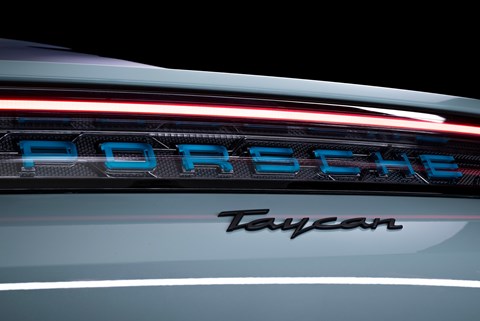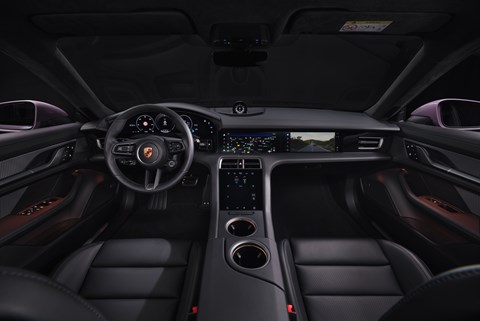► Porsche’s Taycan given a refresh for 2024
► Goes faster and further, and charges quicker
► Prices start from £86,500, includes Sport and Cross Turismo styles
You’re Porsche. Out of nowhere (well, not really, but that’s how it looked to casual observers) you release your first EV, a technically ambitious four-door coupe blending elements of the 911 (style, speed), Panamera (space) and 918 and 919 Hybrids (high-voltage electrical architectures, sledgehammer performance).
What follows is a sales phenomenon. In the UK the Taycan leapfrogged the 911 to run the Macan SUV close time and again for the title of best-selling model. It shifted 150,000 units globally in three years and claimed the number one spot in CAR’s recent exhaustive ranking of every EV on sale.
But progress is inexorable. So, how would you improve the Taycan? And by how much, given prices must inevitably go up, not least because the spicy new electric Macan is more expensive than the piston-engined car it replaces?

The new Taycan (the platform’s dubbed J1 II, an evolution of the original’s J1, so think heavy facelift rather than all-new car) will continue with a number of powertrain and three bodystyle options; saloon, Sport Turismo and Cross Turismo. The rear-drive, single-motor saloon is up to £86,500 (up from £79,200), the popular 4S £95,900 (up from £90,700) and the flagship Turbo S £161,400 (up from £148,300).
More efficiency, more battery, more range
You’d start by giving your new EV all of the above, obviously. You can tell people they don’t need more than 150 miles or so of range – and that smaller batteries make for more efficient EVs – until you’re blue in the face but it won’t land. And why should it? Gassed on a century of fast-fuelling and energy-dense liquid fuels, who wants to worry about eking out every kWh or grinding to a halt on the highway?
Range matters, and the new Taycan has a decent chunk more of it thanks to increased efficiency and an upgrade for its bigger Performance Battery Plus, up to 105kWh gross and 97kWh usable. An all-new unit with new cell chemistry, it brings increased power density, more current and reduced sensitivity to temperature – handy for rapid charging in colder climes.

It flows energy to (and from) a new lighter, more compact and more powerful electric motor, driving a car that’s a smidge lighter than the first-gen Taycan (by around 15kg, despite a more lavish level of standard equipment) and a good chunk more efficient. WLTP power consumption is now 3.45 miles per kWh for the tyre-melting Turbo S (versus 2.84 miles per kWh for the current car) and 3.72 miles per kWh (versus 3.17) for the charge-sipping, single-motor Taycan. Together with the bigger battery, that means range is up by around 35% depending on the model. The flagship Turbo S saloon goes from 291 miles to 391 miles WLTP, while the single-motor, rear-drive Taycan with the optional bigger battery climbs from around 313 miles to a hefty 421.
‘Do they, though?’ I hear you cry, and congratulations on your healthy cynicism. And the answer of course is no, they do not. The true figure? A week before the car’s global reveal we climbed behind the wheel of a single-motor model on low-drag 19-inch wheels and pointed it south from LA to San Diego to find out.
A few hours later we’d managed 365 miles without charging, the consumption read-out showing mostly 3.6 miles per kWh. That’s not 421 miles or 3.72 miles per kWh, granted, but it’s within a sniff of the official consumption and impressive both a) versus the first-gen car and b) for a high-performance EV.
Faster – and faster charging
Did anyone ask for a faster Taycan? No matter. Porsche has built one anyway, upgrading the entire powertrain to boost the Turbos S by 188bhp to 939bhp and the rear-drive car by 80bhp to 402bhp. That’s enough to drop the Turbo S’s 0-62mph time to a breakfast-churning 2.4sec, and the single-motor car’s to a hardly-tardy 4.8sec.

The new model promises to be faster around corners too, having ditched the previous car’s 48-volt roll control system for a version of the Panamera’s electro-hydraulic Active Ride. Air suspension is now also standard, and in too come Porsche’s new two-valve dampers. Our limited experience to date (a twisty-road passenger ride in Germany and the freeway drive in California) would suggest the ride is more compliant and the body control as resolute as ever.
Charging capacity is up 50kW, from 270kW to 320kW, and when you can find a suitably powerful charger the results are impressive. We see 320kW on the charger display in both freezing cold Germany and balmy California, and on one charge take on an indicated 46kWh – or 165 miles of range in the rear-drive car – in just eight minutes.
It’s evolved inside

Just as you’d be forgiven for failing to spot the changes externally, so the new Taycan isn’t an entirely different beast inside, either. But things have changed. The car gets new functionality within its charging planner, such as a list of places to eat and shop in the area, video streaming on the passenger screen (blocked from the driver while you’re moving, but gorge on Ted Lasso by all means as you charge), sleeker instrument graphics complete with an indicator of the car’s readiness for charging, and scope for personalisation within each drive mode (selected via a now standard drive mode rotary controller on the steering wheel) rather than a single customisable Individual drive mode.

There’s also Porsche’s version of CarPlay, co-developed with Apple, which allows you to do stuff like switch radio stations and set the climate control without having to endlessly head out of CarPlay and into the car’s native infotainment. Informed by data running from the car via the My Porsche app into iOS, there’s also now a charging planner within Apple Maps.
Still top dog? Some rivals are more powerful (for now at least – Porsche’s wild ‘Turbo GT’ Taycan, possibly with three motors, looks to be just around the corner), while others go further. But the Taycan’s winning blend of style, speed and usability looks to have remained intact, while range, efficiency, comfort and power have all headed in the right direction. We’d be amazed if they’ve screwed this up.